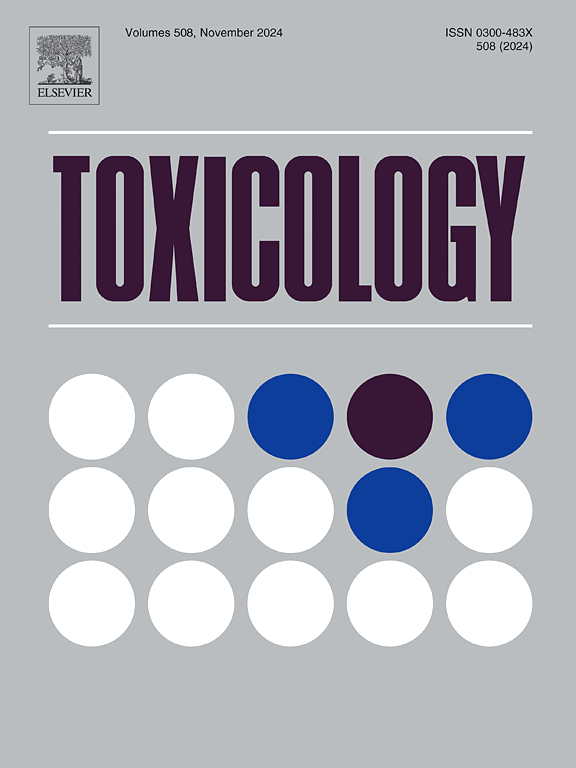镉诱导HEK293细胞分泌受MAPK和NF-κB信号通路调控的SASP因子:镉致急性肾损伤的可能机制
IF 4.6
3区 医学
Q1 PHARMACOLOGY & PHARMACY
引用次数: 0
摘要
镉(Cd)是一种剧毒的环境污染物,它可以在肾脏中积累,诱导细胞损伤并引发炎症反应。然而,Cd对肾毒性的具体调控机制尚不清楚。本实验旨在研究Cd对人胚胎肾293细胞的毒性作用,并探讨其可能的机制。MTT法测定细胞活力。DCFH-DA染色和罗丹明染色检测各组大鼠的活性氧(ROS)水平和线粒体膜电位(MMP)。Hoechst 33258染色检测细胞凋亡。采用8-OHdG ELISA试剂盒检测DNA损伤生物标志物8-羟基-2′-脱氧鸟苷(8-OHdG)的表达。Western blot分析衰老相关分泌表型(senescence associated secretory phenotype, SASP)因子及信号通路。结果表明,Cd暴露可诱导氧化应激和细胞炎症。它还可以损害MMP,促进细胞凋亡,激活MAPK和NF-κB信号通路。最后,暴露于Cd中会引起DNA损伤和SASP的产生。而NF-κB抑制剂BAY11-7082和抗氧化剂NAC可通过抑制NF-κB和MAPK信号通路抑制上述作用。本研究揭示了镉在HEK293细胞中毒性作用的具体机制,为阐明镉的肾毒性提供了有益的信息。本文章由计算机程序翻译,如有差异,请以英文原文为准。
Cadmium induces the secretion of SASP factors regulated by MAPK and NF-κB signaling pathways in HEK293 cells: A possible mechanism of acute kidney damage induced by cadmium
Cadmium (Cd) is a highly toxic environmental pollutant, which can accumulate in the kidney, induce cell damage and trigger inflammatory responses. However, the specific regulation mechanism of nephrotoxicity induced by Cd remains unclear. This study was conducted to investigate the toxic effects of Cd on human embryonic kidney 293 (HEK293) cells and explore its potential mechanisms. Cell viability was assessed with MTT assay. Reactive oxygen species (ROS) levels and mitochondrial membrane potential (MMP) were evaluated through DCFH-DA staining and Rhodamine staining. Apoptosis was detected with Hoechst 33258 staining. The expression of the DNA damage biomarker 8-hydroxy-2’-deoxyguanosine (8-OHdG) was detected with the 8-OHdG ELISA kit. Senescence-associated secretory phenotype (SASP) factors and signaling pathways were analyzed by Western blot. The results showed that Cd exposure could induce oxidative stress and cellular inflammation. It could also impair MMP, contribute to cell apoptosis and activate MAPK and NF-κB signaling pathways. Finally, exposure to Cd triggered DNA damage and SASP production. However, NF-κB inhibitor BAY11–7082 and antioxidant NAC could inhibit these effects by suppressing NF-κB and MAPK signaling pathways. The present study revealed the specific mechanisms of Cd toxicity in HEK293 cells and provided useful information for elucidating the nephrotoxicity of Cd.
求助全文
通过发布文献求助,成功后即可免费获取论文全文。
去求助
来源期刊

Toxicology
医学-毒理学
CiteScore
7.80
自引率
4.40%
发文量
222
审稿时长
23 days
期刊介绍:
Toxicology is an international, peer-reviewed journal that publishes only the highest quality original scientific research and critical reviews describing hypothesis-based investigations into mechanisms of toxicity associated with exposures to xenobiotic chemicals, particularly as it relates to human health. In this respect "mechanisms" is defined on both the macro (e.g. physiological, biological, kinetic, species, sex, etc.) and molecular (genomic, transcriptomic, metabolic, etc.) scale. Emphasis is placed on findings that identify novel hazards and that can be extrapolated to exposures and mechanisms that are relevant to estimating human risk. Toxicology also publishes brief communications, personal commentaries and opinion articles, as well as concise expert reviews on contemporary topics. All research and review articles published in Toxicology are subject to rigorous peer review. Authors are asked to contact the Editor-in-Chief prior to submitting review articles or commentaries for consideration for publication in Toxicology.
 求助内容:
求助内容: 应助结果提醒方式:
应助结果提醒方式:


